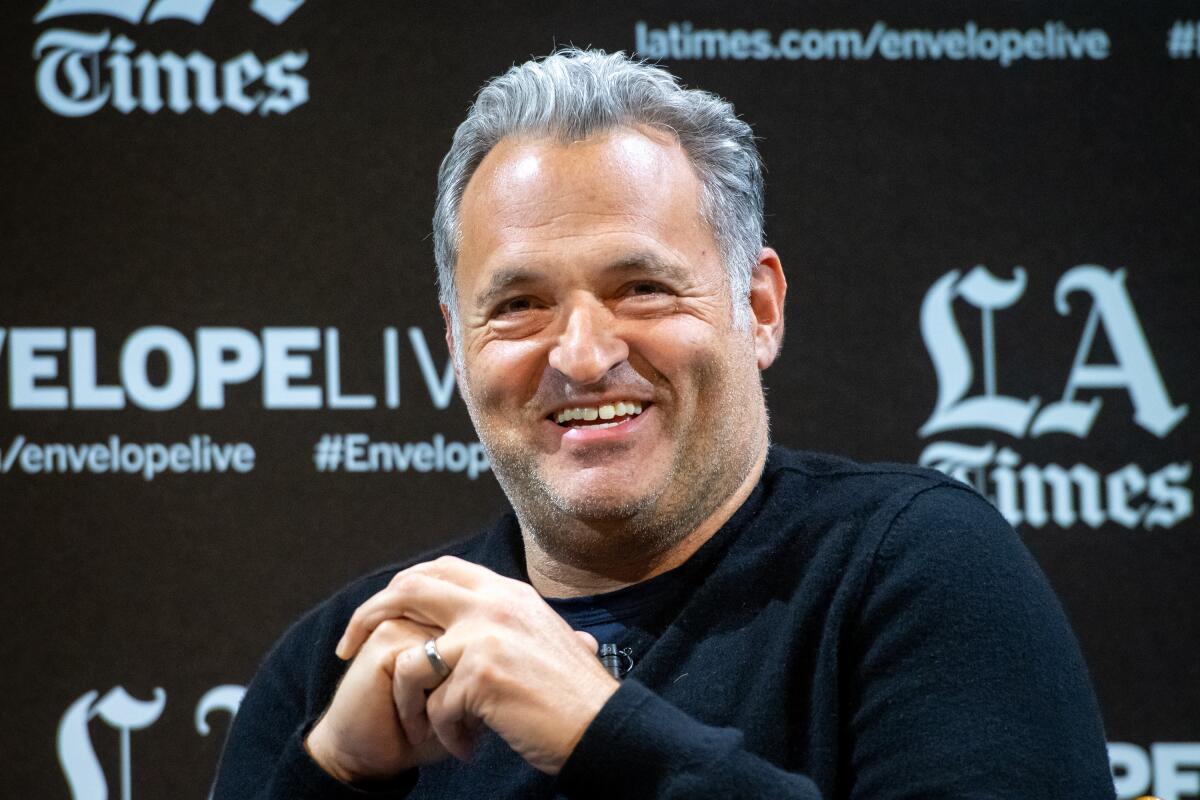There are no words: A man, a dinosaur and a violent world are ‘Primal’
The Envelope Live screening series continued Dec. 4 at the Montalbán in Hollywood with a presentation of the Oscar-contending animated feature “Primal: Tales of Savagery.” The theatrical release compiles the first four episodes of Genndy Tartakovsky’s current Adult Swim series, “Primal.” The animation hero (“Clone Wars,” “Samurai Jack”) was on hand to chat with The Times’ Michael Ordoña about his 2-D, adult-skewing, dialogue-free story of a caveman and a dinosaur bonded by tragedy in a violent world.

“I started to realize more and more that [the nonverbal sequences in my work] were people’s favorites,” he said. “So that’s when I thought, could I tell a whole story of just those sequences?
“I was in a creative rut and wanted to do something very different — I started working on it as a little short film, and I realized it could be so much more.”
Still, he worried people would have difficulty staying with full-length episodes without talking — until he got the best kind of evidence it would work: the nonverbal kind.
“I tell the story of my boss where we were screening one of the chapters ... everybody had pizza. He took one bite and it started, and then he sat the whole way, just holding his pizza like this, not taking another bite.”

Director Genndy Tartakovsky describes how he came to create a show with no dialogue, ironically using words to do so.
The characters’ lack of verbiage doesn’t mean they lack expression, said Tartakovsky, especially when it comes to sound designer Joel Valentine’s work on the dinosaur, Fang.
“I said, ‘Your job is to be the actor for Fang.’ He started to develop this [vocabulary] — it’s not just ‘Roar, roar, roar,’ there’s so much subtlety ... the sound was so important, because it’s her dialogue.”

Director Genndy Tartakovsky discusses how, in the absence of dialogue, sound design in his show is so crucial.
Tartakovsky has developed a following, in part for his distinctive animation style, which makes use of dynamic character positioning that sometimes resembles splash pages from comic books.
“Posing is everything in animation. From the simplicity of Chuck Jones, the way he would do Bugs Bunny … to Jack Kirby, Frank Miller, a lot of the comic books I grew up with in the ‘70s, ‘80s. I can think back to specific drawings and poses from those comic books.”
He referred to cinematic acting styles that used to be more presentational, more theatrical, and how they would leave you with strong visual memories of the performances. Now, though acting styles have changed, he said, filmmakers are “still trying to get these iconic images burned in your head.”
“There’s nothing I like better than when I walk out of a movie theater and I have a frame that I remember because it was so cool and iconic. So I try to make as many of those moments as I can, and posing is a big part of it.”

Director Genndy Tartakovsky talks about the importance of poses in animation.
Now that he’s such a well-established artist, it’s funny to imagine Tartakovsky initially intimidated by others’ work as a young man, but that’s just how he felt when confronted with his classmates’ skill at CalArts.
“By the time I got to CalArts, I thought I was hot ... I’ve got all this experience, I already did two years of film school. And we put our drawings up, and mine is like kid drawings, compared to all these professional, amazing illustrations. I was embarrassed. I didn’t know how I got into the school. I realized I had to work 10 times as much as anybody else just to get to the level where I could be accepted.”

Director Genndy Tartakovsky reveals how his time at CalArts taught him to discover his point of view as an artist.
In a potentially valuable bit of advice for young artists, he shared what he learned after his mind was blown at an even earlier still-life drawing class. He had crafted a straightforward rendering, then saw what the other students were doing.
“Somebody just draws a quarter of the bowl and one orange. ‘Wait, that’s not right.’ And then I see somebody else, and they do a very different composition. And I start to realize, ‘Oh, right. These people are artists, and they have their own .…’ It’s the simplest thing, but I didn’t understand it. I was very photographic, almost. I started to realize, ‘Right, I need a point of view. How am I approaching this fruit?’ Even as stupid as that sounds, it is everything. And from that point, it informed me completely.”

Genndy Tartakovsky’s “Primal” - LA Times exclusive clip from SDCC 2019
More to Read
Only good movies
Get the Indie Focus newsletter, Mark Olsen's weekly guide to the world of cinema.
You may occasionally receive promotional content from the Los Angeles Times.











